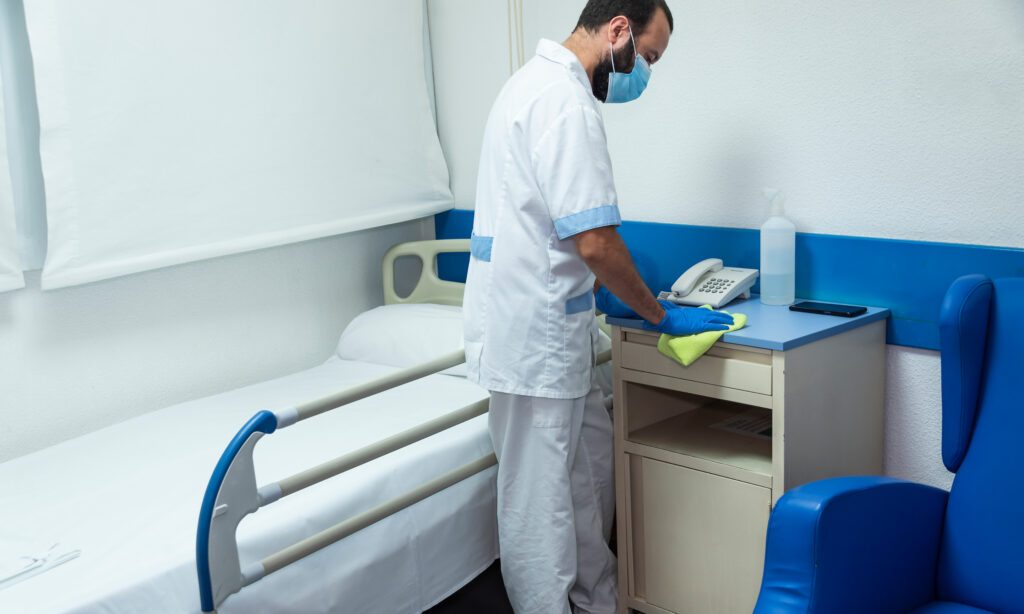We all walk into hospitals with hope, seeking care and healing. The last thing we usually worry about is the cleanliness of the facility itself. Yet, behind the gleaming floors and sanitised equipment, there can be a hidden threat: low-quality hospital cleaning.
This isn’t about a little dust in the corner; it’s about hygiene practices that could make or break a patient’s health and safety.
So, why does hospital cleanliness matter so much, and what are the risks of low-quality cleaning?
The High Stakes of Hospital Hygiene: More Than Just Appearances
Hospitals are home to some of the most vulnerable individuals—patients with weakened immune systems who are highly susceptible to infections. Healthcare-associated infections (HAIs) are a major concern in any hospital, and many of these infections stem from poor cleaning practices.
Think of how many hands touch surfaces in a hospital room—bed rails, IV poles, call buttons. If these aren’t thoroughly disinfected, germs, viruses, and bacteria quickly build up. Low-quality hospital cleaning turns these commonly touched areas into breeding grounds for infections.
Beyond the Obvious: Unmasking the Dangers of Low-Quality Hospital Cleaning
The consequences of poor cleaning in hospitals can be severe. Let’s take a closer look at some of the risks:
- Increased HAIs: One of the most immediate dangers of inadequate cleaning is the rise of HAIs like MRSA, C. difficile, and pneumonia. Poor hygiene allows bacteria and viruses to spread easily, leading to extended hospital stays, expensive treatments, and, in severe cases, death.
- Antibiotic Resistance: When infections spread due to poor cleaning, doctors may turn to antibiotics for treatment. Overuse of antibiotics fuels antibiotic resistance, creating drug-resistant strains of bacteria. This is a global health crisis, and it’s driven in part by the need to combat preventable infections caused by low quality cleaning.
- Compromised Patient Trust: Patients need to feel confident in their hospital’s ability to care for them. A visibly dirty environment erodes that trust, creating anxiety and potentially even hindering the healing process.
Spotting the Red Flags: Is Your Hospital Cutting Corners?
As a patient or visitor, it’s hard to assess every cleaning protocol a hospital follows, but there are some clear warning signs that could indicate low-quality cleaning:
- Visible Dirt or Grime: It seems obvious, but even clean-looking surfaces can be rife with microorganisms if not properly disinfected. If you see dirt, it’s likely there’s more unseen contamination.
- Foul Odours: A lingering bad smell can signal deeper sanitation issues. Hospitals should smell clean, not unpleasant.
- Lack of Hand Hygiene Stations: In hospitals, hand sanitising stations are crucial for infection control. Their absence, or if they aren’t regularly refilled, is a major concern.
- Staff Neglecting Hand Hygiene Protocols: If you notice hospital staff moving from one patient to another without washing or sanitising their hands, it’s a red flag that proper hygiene protocols might be lacking.
Turning the Tide: Combating Low-Quality Hospital Cleaning
While the dangers of low-quality hospital cleaning are concerning, we’re not powerless. There are steps patients, visitors, and healthcare staff can take to improve cleanliness in hospitals and reduce risks:
- Speak Up: If you notice hygiene issues, don’t be afraid to bring them up with hospital staff or administration. Polite feedback can prompt action.
- Practice Meticulous Hand Hygiene: Whether you’re a patient or visitor, hand hygiene is one of the most effective ways to stop the spread of infections. Wash your hands thoroughly and use hand sanitisers frequently.
- Support Hospitals that Prioritise Hygiene: If possible, choose hospitals with a proven track record of cleanliness. Research healthcare facilities in your area and opt for those that demonstrate a commitment to hygiene.
A Clean Bill of Health: Prioritising Hygiene for Safer Healthcare
Low-quality hospital cleaning is a silent but significant threat. By understanding the risks and knowing what to look for, you can advocate for higher standards of hygiene in healthcare facilities.
The stakes are too high to ignore—proper cleaning isn’t just about appearances. It’s about protecting lives. Hospitals that invest in rigorous, high-quality cleaning practices safeguard not only the health of their patients but also their reputation as safe, reliable care providers.
For hospitals, it’s clear: maintaining a clean environment isn’t optional. By reducing infections, addressing hygiene concerns, and supporting antimicrobial resistance efforts, they ensure their role as true healing spaces. For those looking for top-tier cleaning services that meet these high standards, Perth Express Cleaning provides expert cleaning solutions tailored for healthcare environments.
Frequently Asked Questions
How can I find out about a hospital’s cleaning protocols?
Many hospitals publish their infection control policies online, or you can contact the hospital’s patient advocacy department for information.
Should I bring my own cleaning supplies to the hospital?
It’s not advisable. Hospital-grade disinfectants are specially designed to kill specific pathogens. Bringing your own supplies may not be effective or compatible with the facility’s cleaning products.
What should I do if I suspect I contracted an infection at a hospital?
Contact your healthcare provider immediately to discuss your symptoms and possible exposure. Reporting it to the hospital administration is also important.
Are there organisations that monitor hospital hygiene standards?
Yes, organisations like The Joint Commission and The Centers for Disease Control and Prevention (CDC) provide guidelines, conduct inspections, and monitor compliance with hygiene standards in hospitals.
Can I sue a hospital for low-quality cleaning?
In cases where negligence in hospital cleaning leads to harm, legal action may be possible. Consult a legal professional who specialises in medical malpractice to understand your options.


 1300 194 658
1300 194 658 info@perthexpresscleaning.com.au
info@perthexpresscleaning.com.au